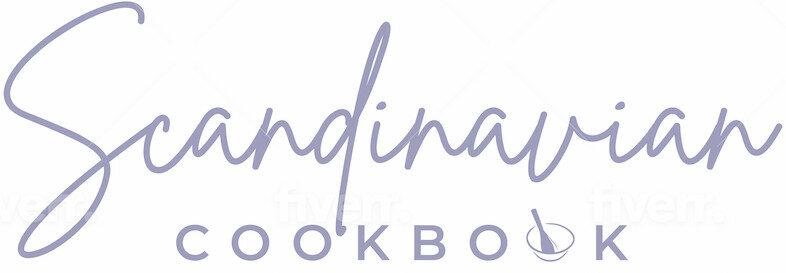17 Traditional Norwegian Recipes
I first started this blog by working my way through Den Rutete Kokeboken, a classic Norwegian cookbook first published in 1980. This cookbook is full of traditional Norwegian recipes, and still today you’ll find this cookbook in many Norwegian kitchens. I love classic Norwegian food, and so today I’m sharing some of my favorite traditional Norwegian recipes.
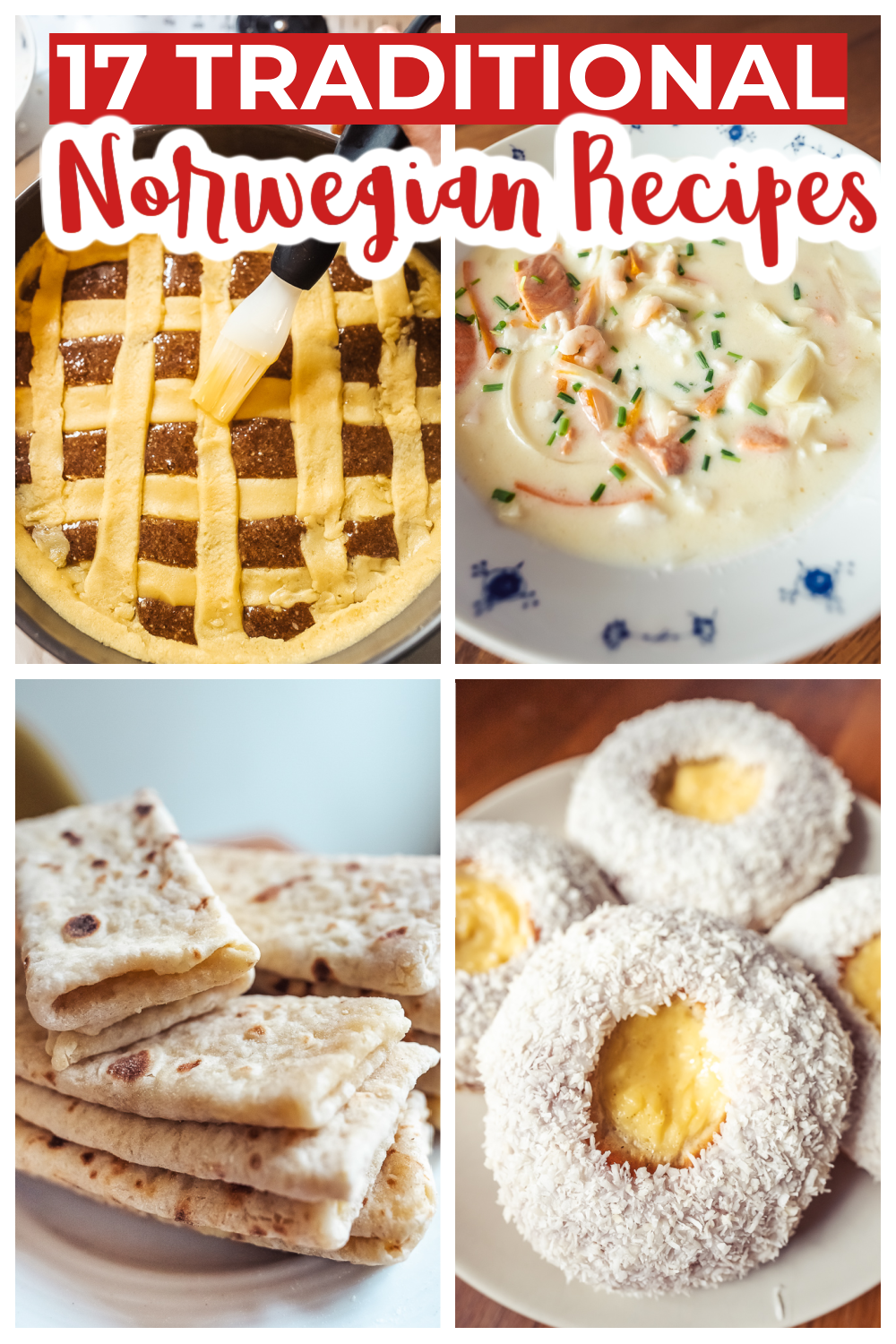
Rømmegrøt
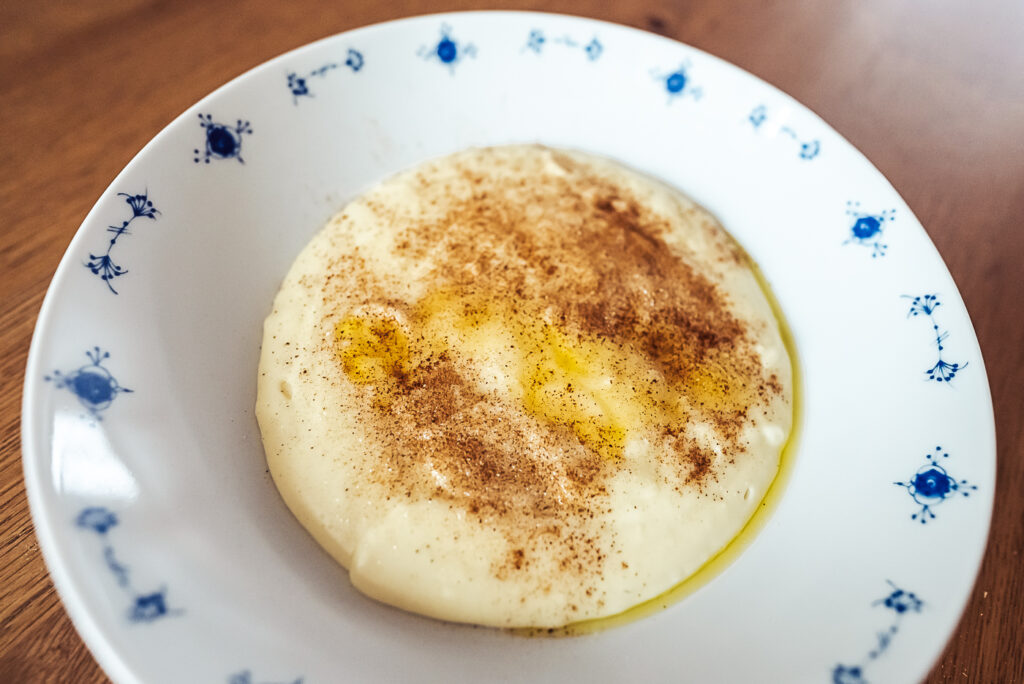
One of my favorite traditional Norwegian dishes is rømmegrøt, or sour cream porridge. Porridge is one of the oldest hot dishes in Norway, and Norwegians have been making sour cream porridge for centuries.
Rømmegrøt is a porridge made with sour cream, milk, and a bit of flour, and then topped with cinnamon and sugar. Norwegians usually serve rømmegrøt with a glass of raspberry juice on the side, as well as sometimes cured meat and Norwegian flat bread. I’ve shared my rømmegrøt recipe here.
And if you’re looking for other easy Norwegian recipes, I’ve shared my seven favorite easy Norwegian recipes here:
Skolebrød
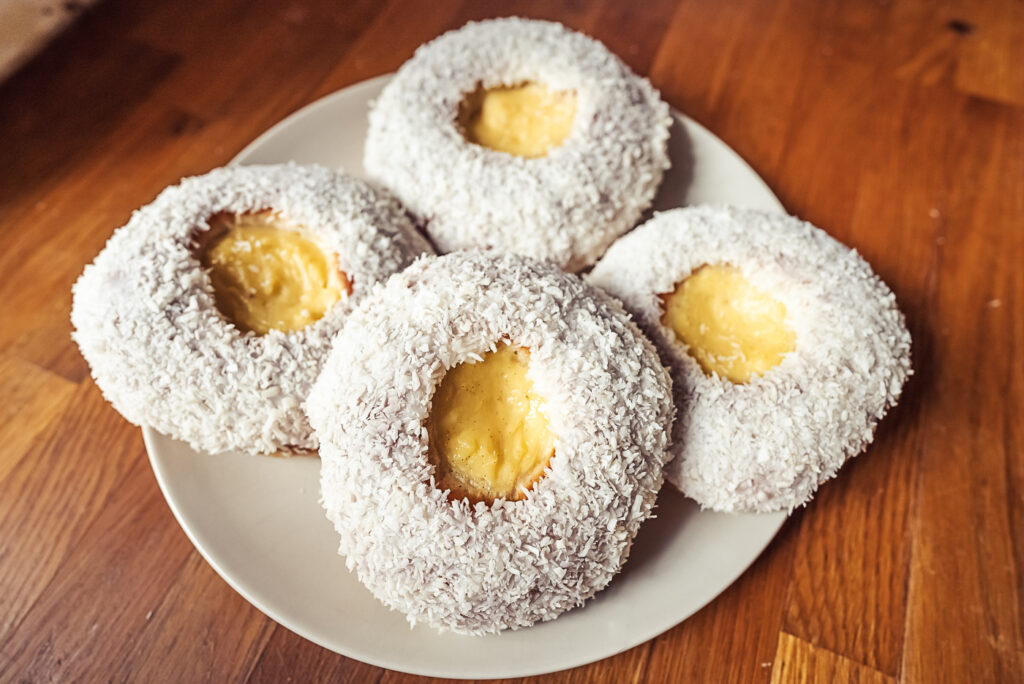
Skoleboller (also called skolebrød) are Norwegian “school buns” made with a sweet cardamom dough, filled with vanilla custard in the center, and then coated in icing and dipped in coconut flakes. They first appeared in Norway in the 1950s and have been a Norwegian favorite ever since.
I’ve shared my skoleboller recipe here.
Waffles
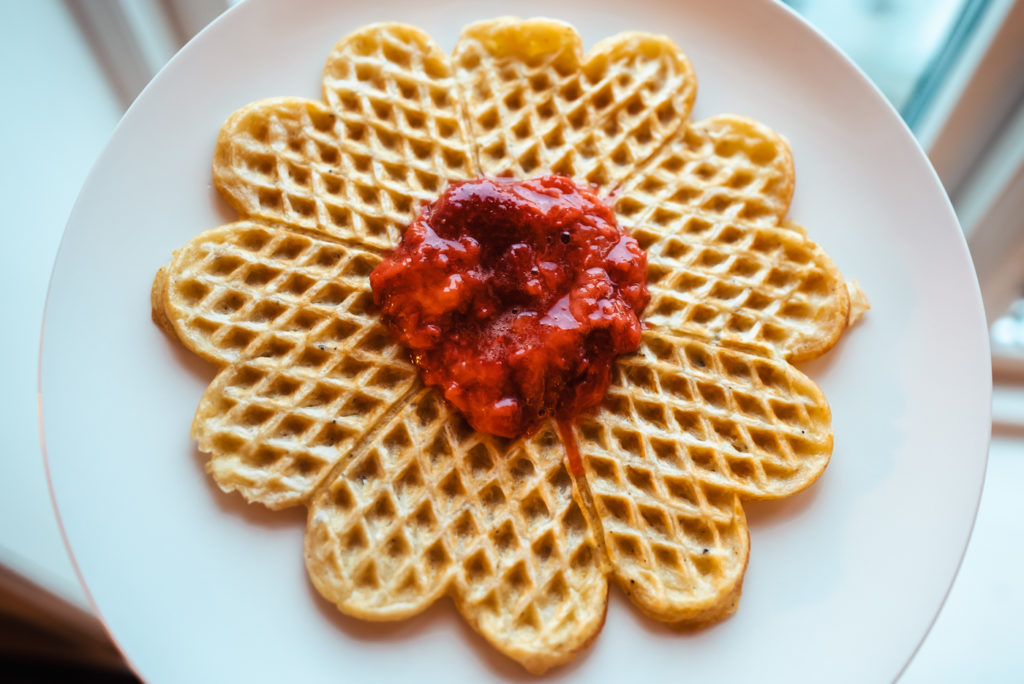
Norwegians have been eating waffles for hundreds of years, and they’re still a weekly staple for many families here. In fact you can see Norway’s oldest waffle iron, from 1685, at the Norwegian Museum of Cultural History in Oslo.
Norwegian waffles are thinner (and tastier!) than Belgian waffles, and they’re spiced with freshly ground cardamom. I’ve shared my Norwegian waffle recipe here.
Munker
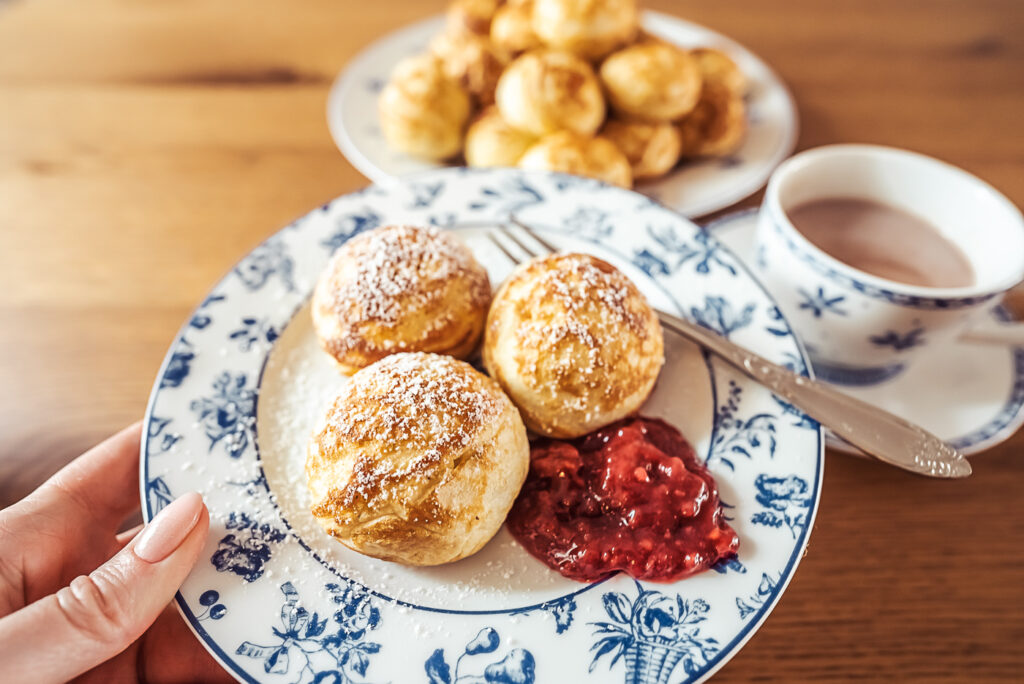
Munker are spherical pancake-like snacks, incredibly light and fluffy and usually sprinkled with powdered sugar and served with raspberry jam. They’re considered quite old fashioned here in Norway, however in Denmark you’ll see them in supermarkets and street stalls every winter. In Denmark they’re called æbleskiver.
I’ve shared my munker (æbleskiver) recipe here.
Toast Skagen
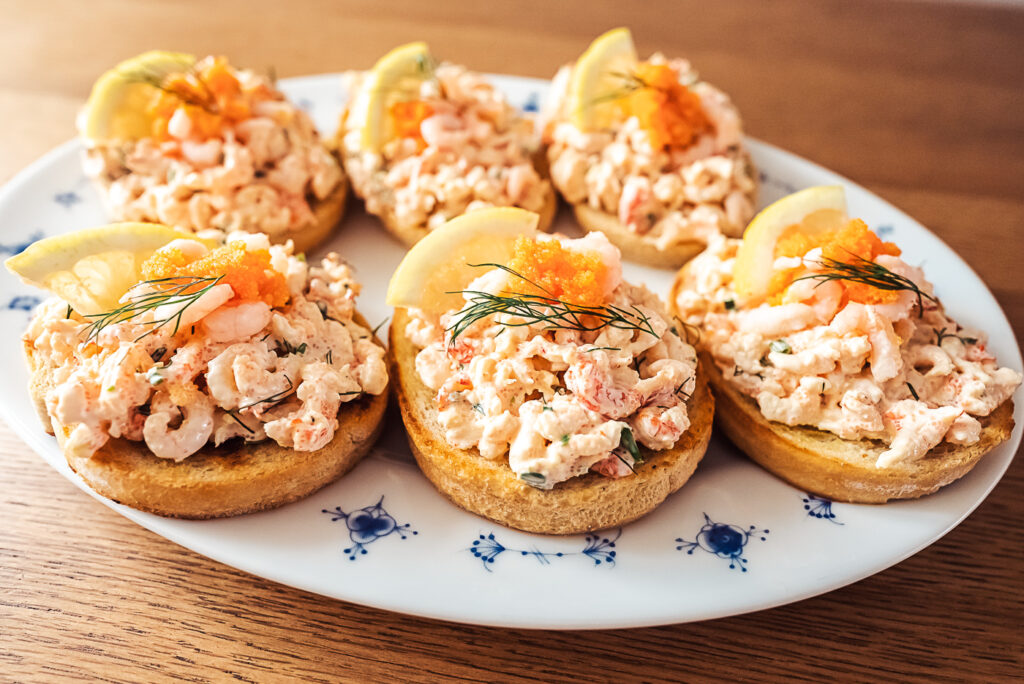
While Toast Skagen does originally come from Sweden, it’s become a Norwegian tradition as well.
Toast Skagen is made with toasted white bread topped with a heaping portion of Skagenröra, which is a Swedish shrimp salad usually made with shrimp, dill, chives, and a dressing of lemon juice, mayonnaise and sour cream or crème fraîche. The Skagen Toast is then topped with lemon, fresh dill and a spoonful of fish roe before serving.
I’ve shared my Toast Skagen recipe here.
Lefse
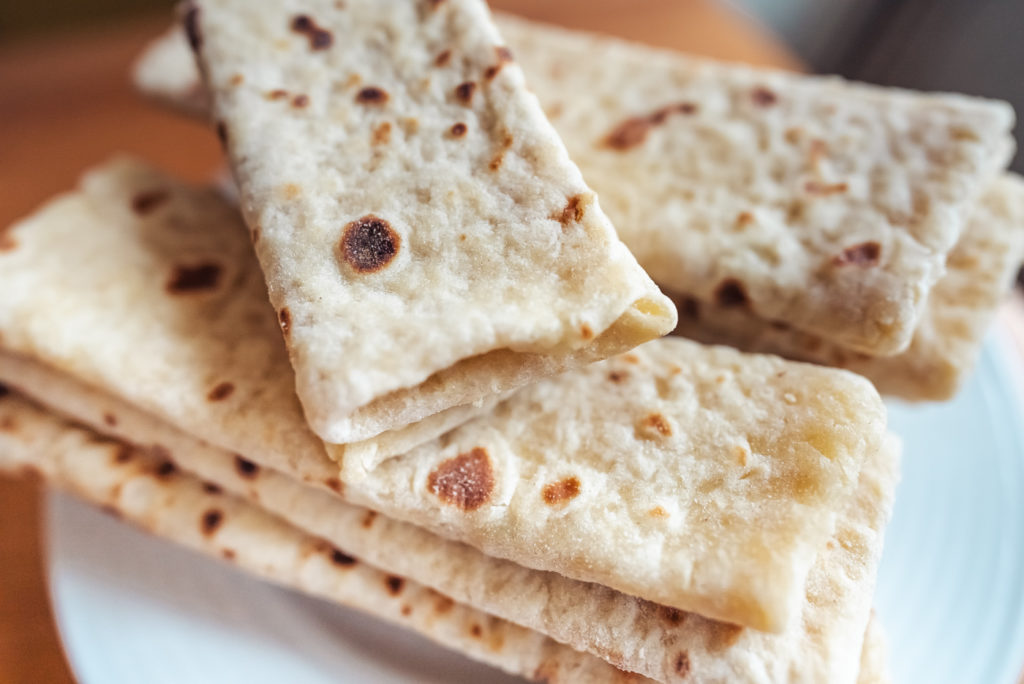
Lefse is perhaps the most famous traditional Norwegian food, at least amongst Norwegian Americans. Lefse is a soft Norwegian flatbread made with flour and sometimes potatoes, which is filled with butter and sugar to make kling. It’s often eaten as a snack or sweet dessert.
Kling is actually one of my favorite Norwegian desserts, but I don’t really like the store bought version, so if I want to enjoy it I have to make it myself. I’ve shared my potato lefse and kling recipe here and my semolina lefse recipe here.
Fiskesuppe
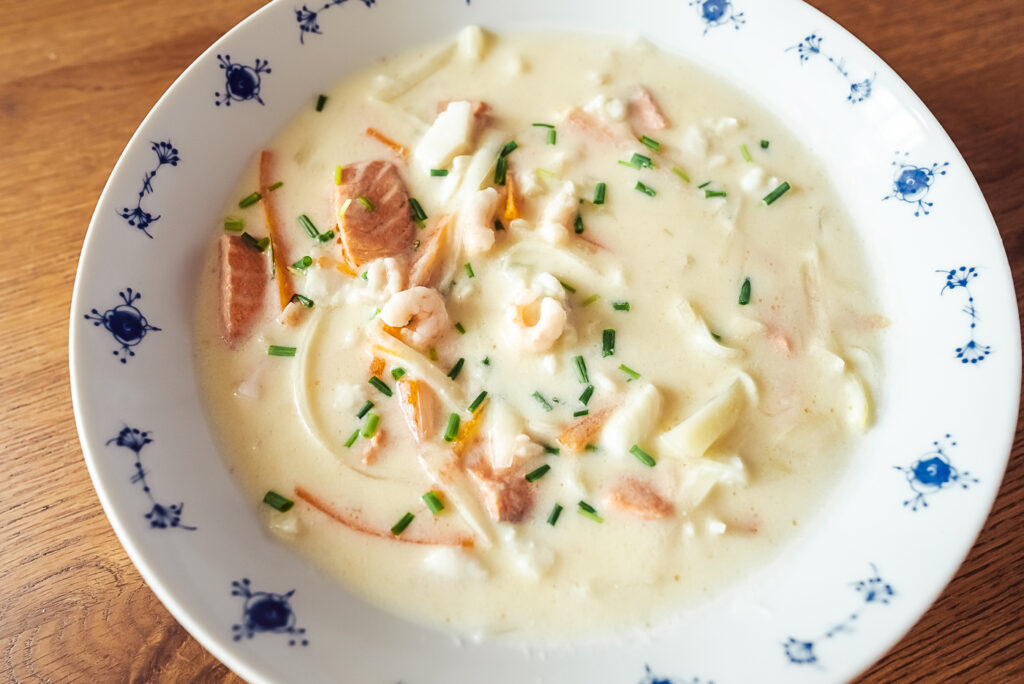
Creamy fish soup, or fiskesuppe, is a Norwegian classic that we love to make year round. We are incredibly proud of our fish soup, and for good reason – it’s so delicious.
In fact, this fish soup recipe is so easy and delicious that it’s probably the recipe on this blog that I make the most often. I’ve shared my Norwegian fish soup recipe here.
Fårikål
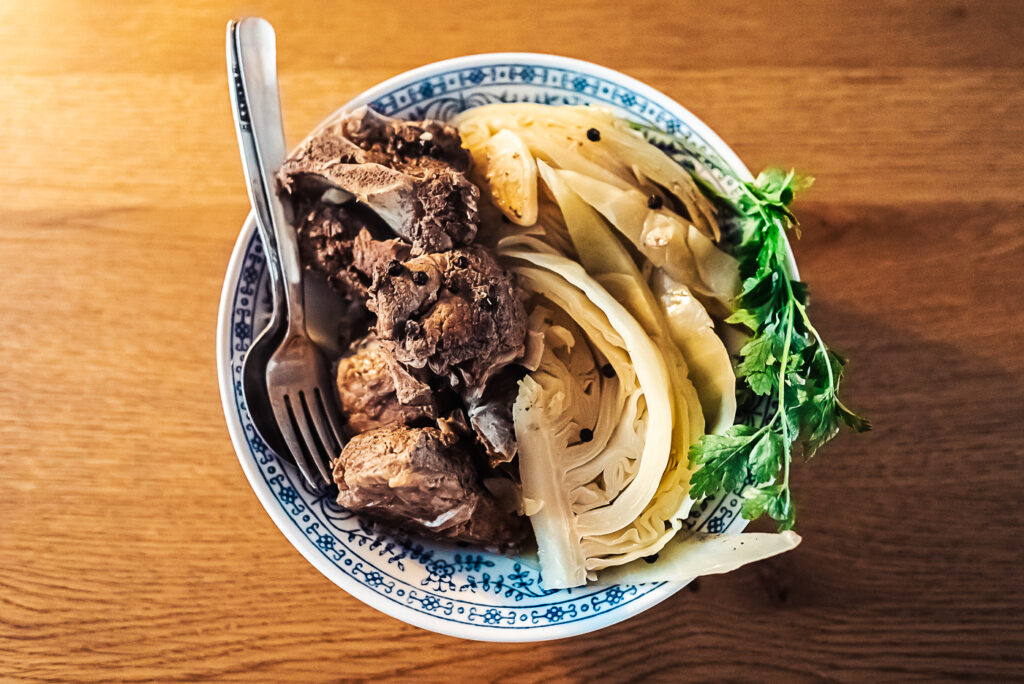
Fårikål, literally “mutton in cabbage” is a traditional Norwegian stew made from mutton (or these days often lamb), cabbage, whole black pepper corns, and a bit of salt and water. It’s usually served with a side of boiled potatoes, and it tastes even better the next day.
Fårikål was named the national dish of Norway in 1972, and then again in another national vote in 2014, when fårikål narrowly beat out meatballs with brown sauce. And it does feel fitting for Norway’s national dish to feature lamb and potatoes, two local products Norwegians are incredibly proud of.
I’ve shared my fårikål recipe here.
Raspeballer

If you’ve visited Bergen on a Thursday, you might have experienced our Thursday meal tradition, raspeballer.
While Norwegians will make raspeballer at home on any day, most restaurants here in Bergen will only serve raspeballer on Thursdays. Thursdays used to be the biggest shopping day of the week, with stores being open 6 or 7 pm instead of 4 pm. So to tempt shoppers to eat out, restaurants would serve a cheap, hearty Norwegian favorite: raspeballer.
Raspeballer are traditional Norwegian potato dumplings, also called komler, komper, klubber, and potetballer, among other names.
Raspeballer are usually made with a combination of cooked potatoes and grated raw potatoes, mixed with a bit of barley and/or wheat flour and boiled in broth. Some Norwegians make raspeballer “with dots,” where they include bits of bacon in the potato dumplings.
I’ve shared my raspeballer recipe here.
Karbonader
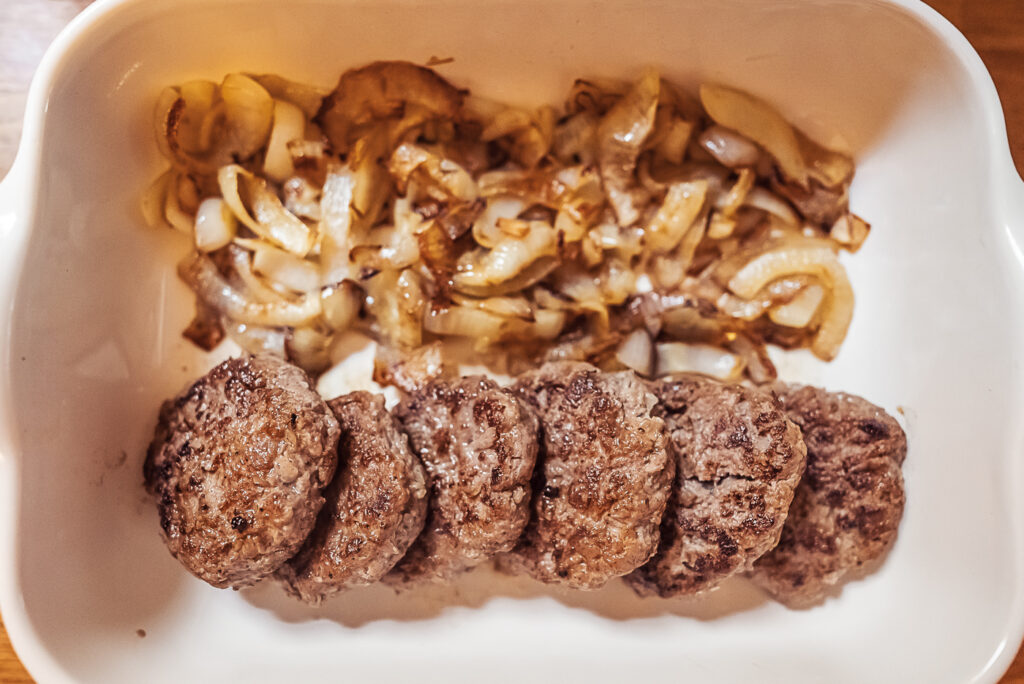
If you’re looking for hearty, traditional Norwegian food, you’re looking for karbonader. Karbonader are meat patties made with ground beef with less than 5% fat. They’re often eaten with potatoes, stewed peas, and caramelized onions, or on bread, often with a fried egg on top.
I’ve shared my karbonader recipe here.
Lapskaus
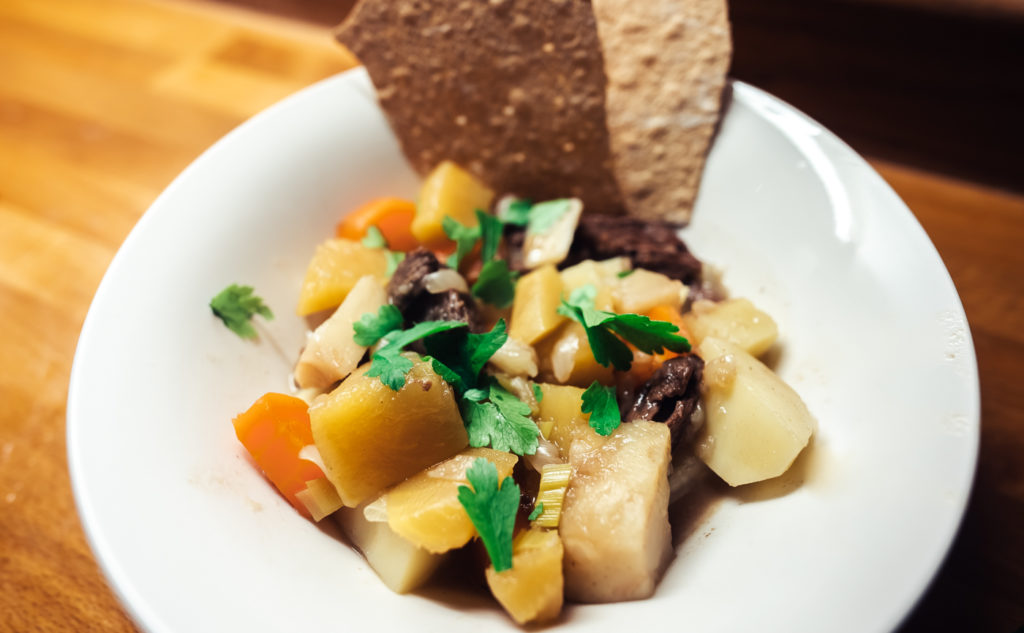
Lapskaus is a traditional Norwegian stew, usually made with beef and root vegetables. Fisherman first brought lapskaus to Norway, and now it is another favorite hearty Norwegian meal.
The two main types of lapskaus are lys (light) lapskaus, and brun (brown) lapskaus. Lys lapskaus is usually made with pork, but sometimes beef, and the meat is cooked in the broth. With brun lapskaus the meat is browned in a pan before adding the stock.
I’ve shared my brun lapskaus recipe here.
Kransekake
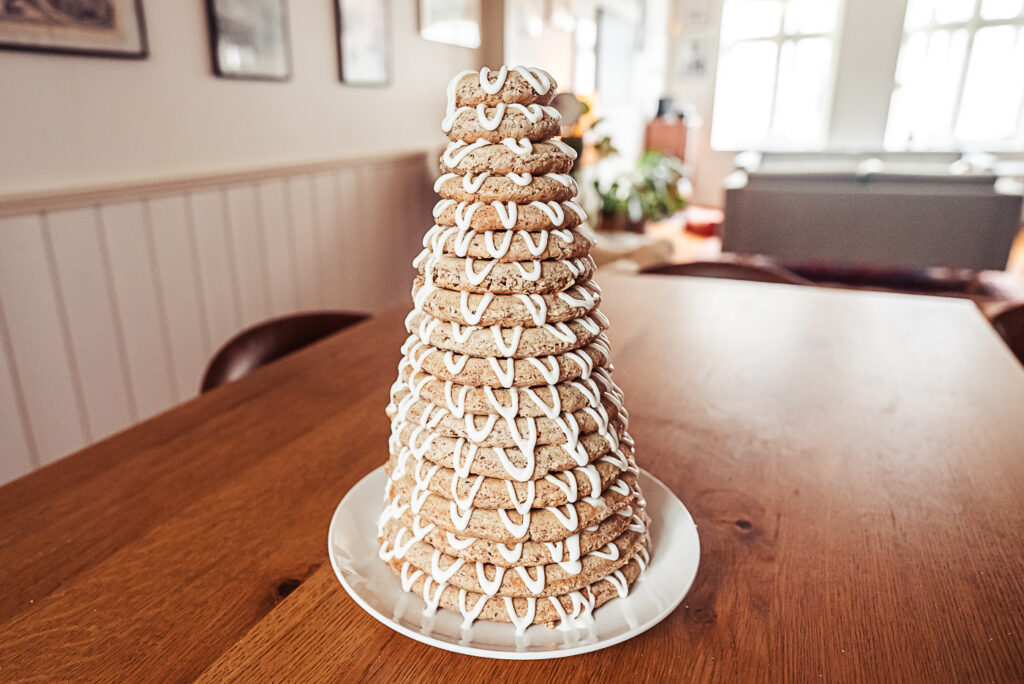
A classic Norwegian almond cake that you’ll see at all sorts of celebrations in Norway is kransekake, which translates to “wreath cake.” Kransekake is a chewy almond cake made of a set of rings piled on top of each other to form an impressive tower.
This can be traced back to the 1600s with the French tradition of presenting cakes and pastries in tower forms. Hanna Winsnes shared her kransekake recipe in the mid 1800s.
You can find my kransekake recipe here.
I’ve shared my five favorite Norwegian cakes here:
Success Cake
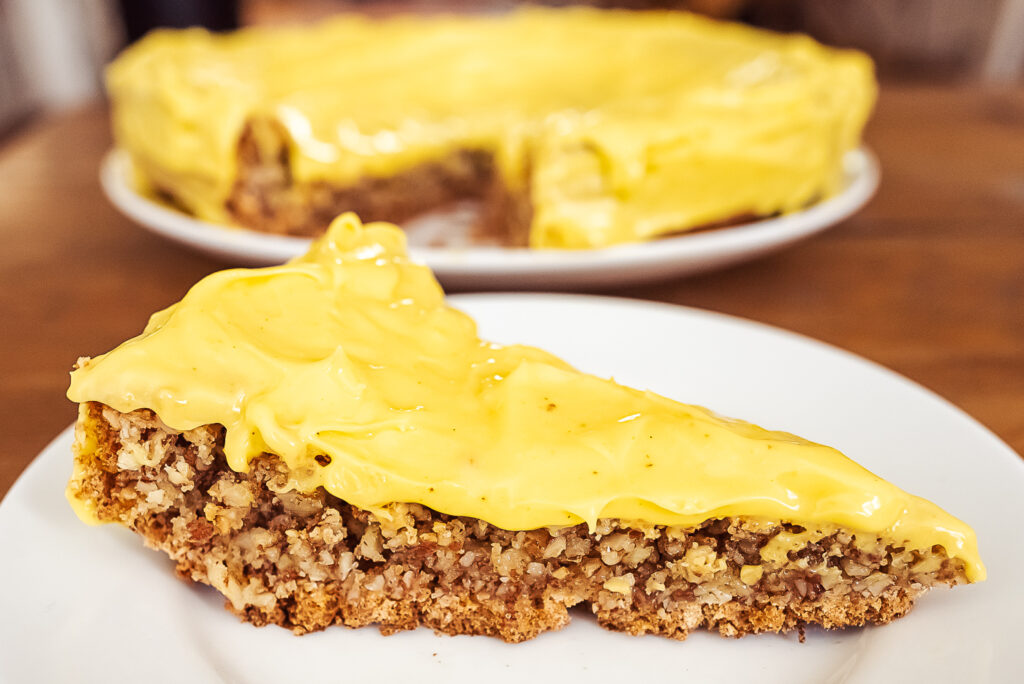
Probably my favorite Norwegian dessert of all is suksessterte, also called suksesskake and gulkake, or success cake in English. Suksessterte is a Norwegian almond cake with a creamy egg cream frosting.
Suksessterte was first named in “Den lille bakeboken” which was actually a translation of a Swedish cookbook. In the Swedish version the cake is called King Oscar II’s cake.
Apparently suksessterte was often served at Swedish royal engagements at the end of the 19th century and it was King Oscar II’s favorite cake. Though interestingly King Oscar II also ruled Norway from 1872 until Norway gained independence in 1905. So I guess since he was ruling over Norway, that makes the cake Norwegian as well?
I’ve shared my mother’s success cake recipe from the 1980s here. This recipe comes from Norwegian Queen Sonja’s own handwritten cookbook.
World’s Best Cake
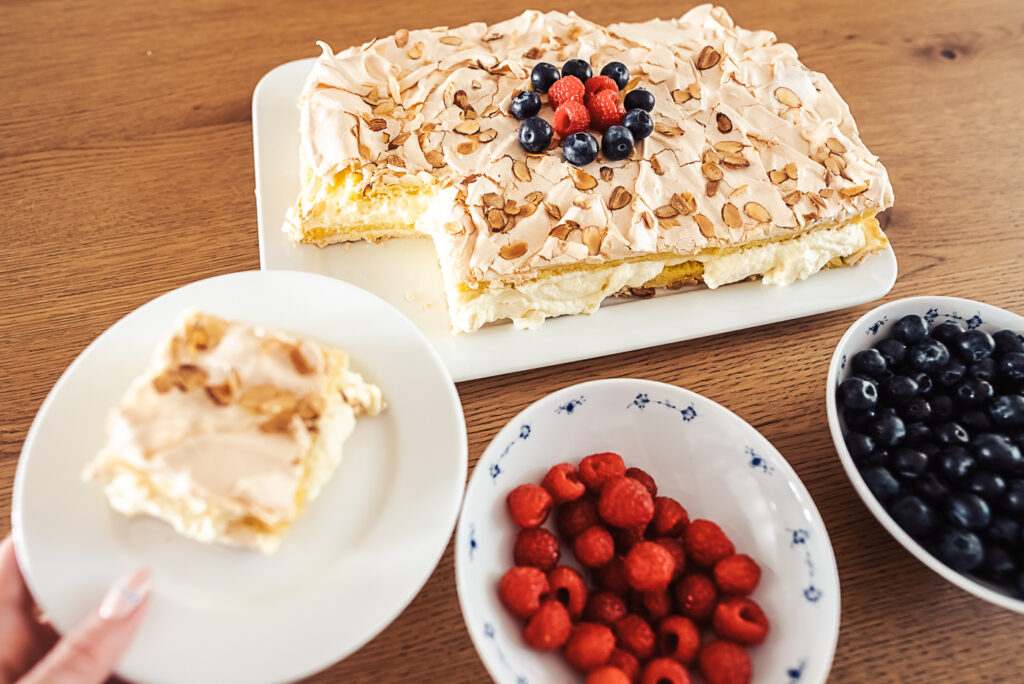
Norwegians refer to kvæfjord cake (kvæfjordkake) as simply verdens beste, or the world’s best cake. In fact some of my friends here in Norway didn’t even know that verdens beste is officially called kvæfjordkake.
Kvæfjord cake got its name from the two sisters from Kvæfjord who first made this cake at Café Alliance in Harstad in the 1930s. Eventually in the 1970s a Norwegian magazine shared the recipe, making the cake a nationwide hit.
And Norwegians love verdens beste so much that in 2002 they voted it as the national cake of Norway.
Verdens beste is a meringue topped sponge cake filled with a velvety vanilla cream. I’ve shared my world’s best cake recipe here.
Krumkaker
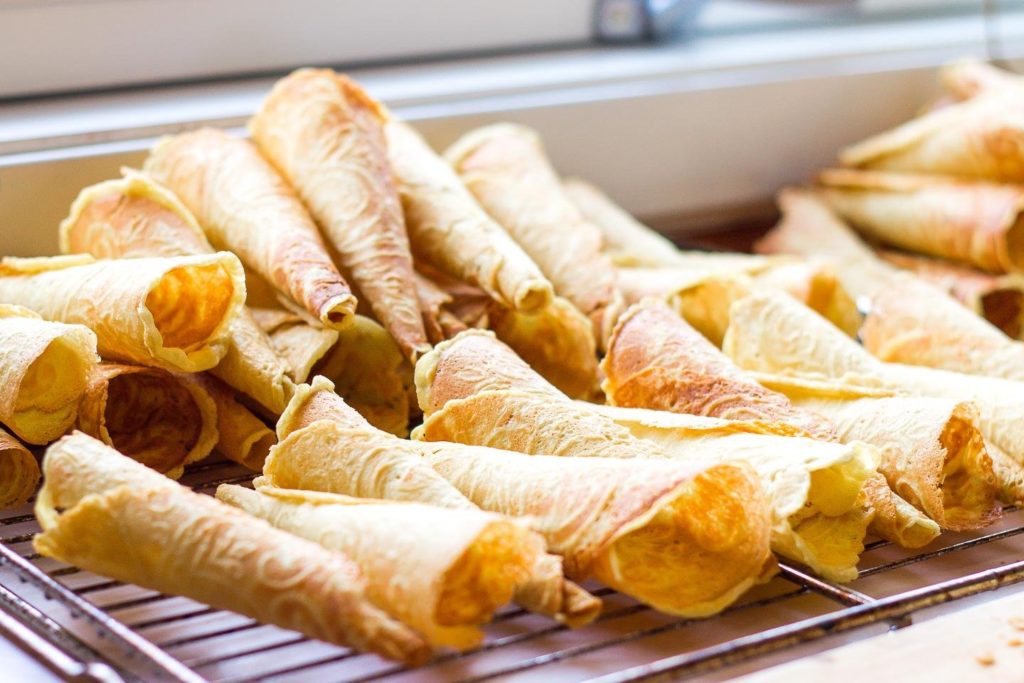
Krumkaker are thin cardamom spiced cookies made on a krumkake iron and then shaped into a cone or cup. Krumkaker are the oldest Norwegian Christmas cookies that we know, with the first krumkake iron dating back to the 1500s.
I’ve shared my krumkake recipe here.
Fyrstekake
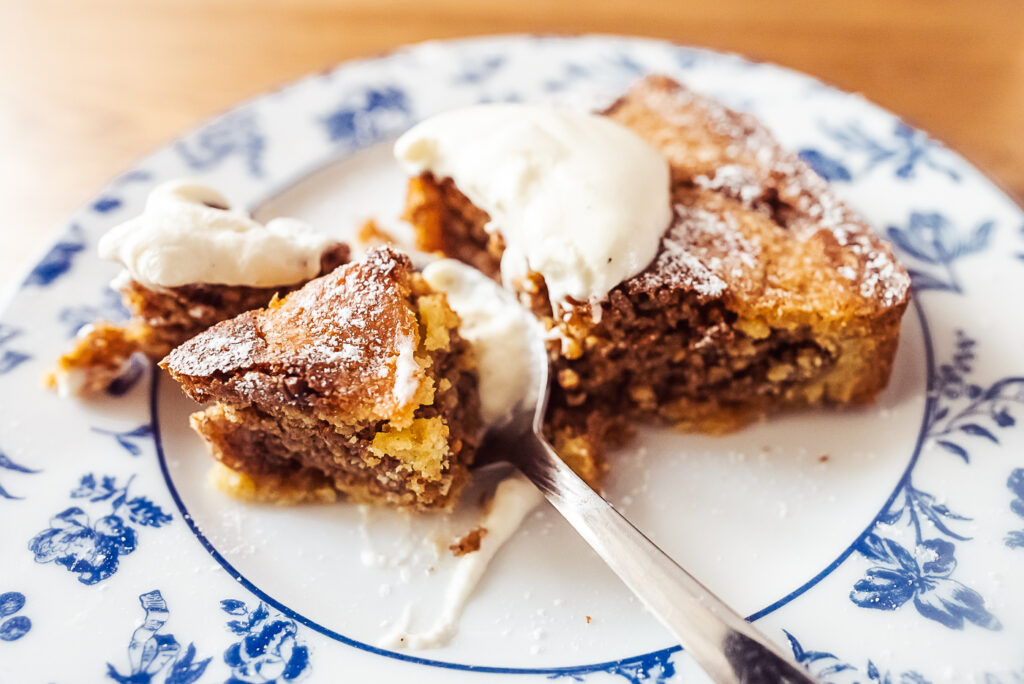
Fyrstekake, or Norwegian prince cake, is a vanilla lattice pie with a soft almond filling. Prince cake tastes great warm out of the oven topped with whipped cream, but it might be even tastier the next day.
Fyrstekake was developed in the 1860s at Erichsen’s Bakery in Trondheim. It’s definitely considered a bit old fashioned now in Norway, but it’s one of my favorite Norwegian desserts! I’ve shared my fyrstekake recipe here.
Mazariner
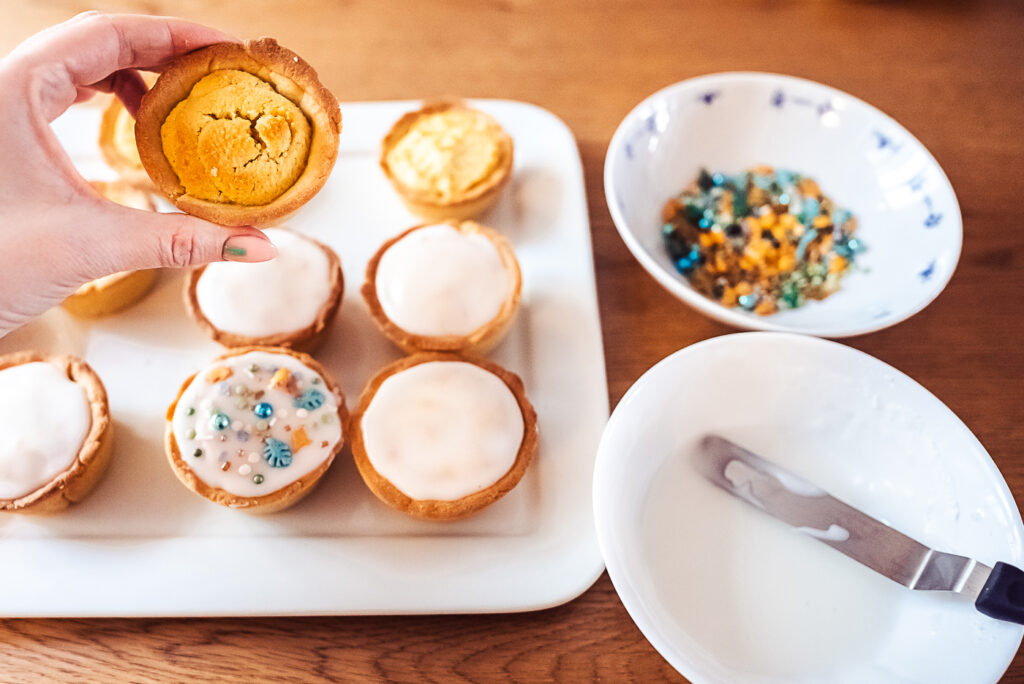
My favorite sweet treats to buy at bakeries in Norway are mazariner. Mazariner are simple but oh so tasty almond tartlets with a shortbread cookie shell and almond filling. Apparently mazariner originally come from Sweden, but they are just as popular here in Norway.
Mazariner are considered more of a retro sweet these days, but you still often see them in Norwegian bakeries, as well as in Sweden and Denmark.
I’ve shared my mazariner recipe here.
